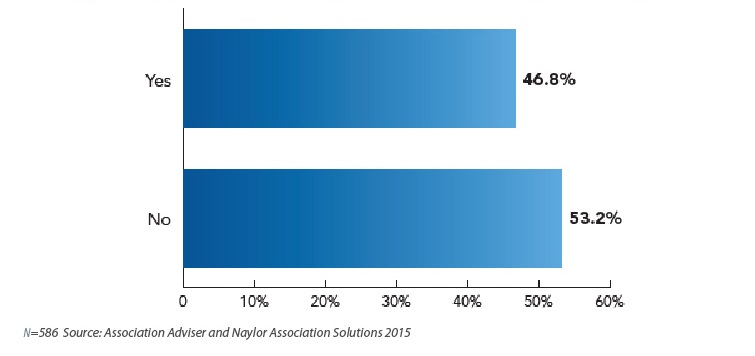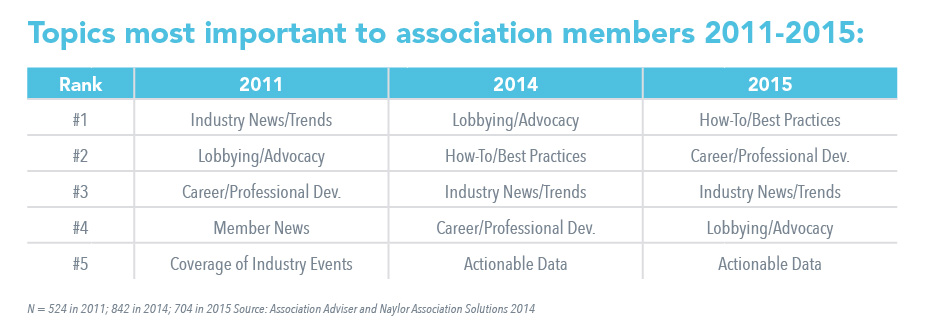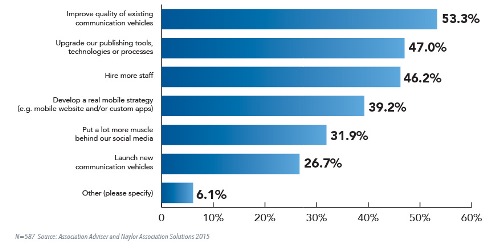11 Questions You Must Ask Yourself

Do you really know what you and your association are best at?
As members of a fast-moving, competitive society, it’s in our DNA to keep score and measure our progress. It doesn’t matter if we’re talking about sports, business, GPAs, salaries, horsepower, home values or investment portfolios.
Associations are no different. You want to keep up with your peers and hopefully move the needle in a positive direction. You keep increasingly careful tabs on membership gains and losses, changes in operating revenue, followers of your social media channels, visitors to your website and career center, performance of your marketing campaigns and publications, and so much more. You also keep tabs on what competitors are offering members, when they’re offering it, and at what price.
At a recent ASAE panel discussion I attended, Beth Bush, marketing director for the American Association for the Advancement of Science, observed, “Data is king. You have to make the investment in data collection cleansing and analysis if you want to be a relevant association today.”
Thanks to association management software (AMS) solutions, online survey tools and Web analytics, associations have become very good at collecting data — in fact, many tell us they’re drowning in it — but all too often they’re measuring what’s easy to measure rather than what they really need to measure.
Make the commitment to measuring what you need to measure, not what’s easy to measure.
Ask members, volunteers and sponsors how you’re doing. You might not like their answers, but they’ll respect you more in the long run.
You can’t be all things to all people. Data will help you understand what services you’re best positioned to provide.
Challenge survey respondents to think big, not just to fill in the blanks.
Case in point: Our annual association communication benchmarking study found that less than half of associations (46.8 percent) regularly ask their advertisers and sponsors if they feel they’re getting their money’s worth (down from 52.6 percent in 2014).
On an annual basis, do you interview or survey your advertisers/sponsors to determine if they feel they are getting their money’s worth with your organization?

On a positive note, among associations that do ask, three out of four (75 percent) told us they are incorporating the feedback they get from advertisers and sponsors into their pricing considerations — up from 60 percent who said so in 2014 and up from 62 percent who said so in 2011. That said, sometimes the truth hurts. As I mentioned last month, the great Albert Einstein argued you can’t solve new problems with the same thinking that created them.
Facebook likes, newsletter opens, website hits and webinar registrations are examples of McMetrics™ — addictive, cheap and easy to collect. This data fills you up quickly, but doesn’t offer much in the way of long-lasting nutritional value.
Example: Suppose you saw a spike in membership and Facebook likes about three months after changing your logo and incorporating it into your channels. Was the new design the direct cause of your membership spike, or was it because the process of redesigning your logo forced your organization to put some real thought into branding, value proposition, membership needs and the timing of your campaigns? It’s easy to jump to the wrong conclusion in order to justify a big resource investment.
Another example: If you’re a regular reader of this newsletter, you’ve been part of an interesting experiment. Two weeks after publishing, we discovered if we send Association Adviser to everyone who did not open it the first time, we get open rates almost as high as we do from the original push. Same content, same subject line, same time of day. Putting data in its proper context takes it from “ho-hum” to “Hmm!”
We know what the analytics say, but sometimes the real world creeps into data. You might have too many meetings on your calendar or too much email in your inbox when we send. You might be traveling or dealing with issues on the homefront. We’re all human. What we do know is you’re super busy. You’d have opted out of Association Adviser long ago if you didn’t find it useful.
11 Must-Ask Questions (9+2)
Josh Linkner, keynote speaker at last month’s ASAE annual meeting and a highly successful tech entrepreneur, said great leaders and innovators have insatiable curiosity and ask themselves nine critical questions to map their path to success. It’s interesting to see how many of the nine questions below require some element of measurement or quantification:
- Why am I doing it?
- What is my big vision?
- What’s my realistic starting point?
- Who (or what) is my enemy?
- What resources do I need?
- Who needs to help me?
- How will I measure it?
- How can I break it into manageable tasks?
- When can I begin?
According to Linkner, “The old adage, ‘What gets measured gets improved,’ is spot on if you’re looking to drive big results.”
Bush observed, “Associations are on the top of the life cycle curve, soon to be on the declining side unless major changes are made. We need for our business model to change or we won’t be in business much longer.” Bush said there are two questions you should always answer before considering a new communication channel, product or service:
- What do we do better than anyone else?
- Who needs [what we offer] the most?
Before you conduct your next member survey or focus group, please consider Linkner’s nine questions and Bush’s two questions above.
Steve Smith, CEO of the American Academy of Hospice and Palliative Medicine, told us on Association Adviser TV (1:59), “It’s important to pay attention to the trends and what [members’] greatest needs are, but we must also understand what we’re best positioned to provide.” You can’t try to provide them with everything. “It’s important to know what your sweet spots are and play to those strengths,” He said.
Smith also said you should recognize certain things you’re providing that might be better left to others to provide. Abe Eshkenazi, CEO of APICS, explains in this month’s Corner Office profile that associations are in the “needs-filling business” first and foremost.
So, how often do you ask members what needs you can fill? At the ASAE annual meeting last month, Laurie McIntosh, membership director for the Society for Human Resource Management (SHRM), said you should do surveys consistently and regularly — quarterly is fine. Just remember to do them on different topics each time. For example, every three months alternate between member satisfaction, conferences, professional education, and other must-know topics. There are several good reasons for following McIntosh’s advice. First, your research efforts can be turned into revenue-producing industry surveys. Second, by asking about certain topics on a consistent basis, you can get an eye-opening perspective on how things are changing year-over-year (see table below).
As many of you know, Association Adviser conducts an annual comprehensive benchmarking survey about association communication trends and best practices. Every year since 2011, we’ve asked over a thousand association leaders from over a hundred industries which topics are most important to their members. If we just looked at 2015 data, we’d say “how-to,” “best practices” and “career development” are top of mind of members. But, the top topics have greatly changed since 2011. As recently as four years ago, it was all about industry and member news, trends, lobbying and advocacy.
Back then, it was about the association. Today, it’s about the member and what you can do for them.
Contact us for full report to see other years.

Jenny Matthews, executive director of the Tennessee Society of Association Executives, agreed. In an Association Adviser TV video interview, she said, “The younger generation really wants to know: ‘What am I getting for my dollar? Show me that benefit.’”
It’s also important to challenge respondents to think big from time to time, not just to fill in the blanks. One of our most popular aspirational questions every year is:
If your publishing/content creation team unexpectedly received a 50 percent increase in the annual budget, how would you recommend they spend it?
Thanks to time series data, we have learned “improving the quality of existing communication vehicles” has supplanted the need to “upgrade tools, technologies and process” as the No.1 priority. Additionally, we learned the need to invest in a real mobile strategy has gained the most attention since 2014, and the need to increase staffing has gained the most attention since 2011.
As one respondent shared in response to how his association would handle a 50 percent communication budget increase: “Get outside expertise to craft a better strategy and develop tools so we can use inside staff more effectively to execute it.”
Just remember that no matter how rigorous and methodologically air tight your survey is, the research will only take you so far if you don’t include follow-up phone interviews — or better yet, face-to-face visits with respondents (i.e., your members or prospective members).
Annette Homan, deputy executive director of the Risk and Insurance Management Association (RIMS), explained in this month’s episode of Association Adviser TV (1:28), that face-to-face interaction is a great way to ask questions that will lead to more in-depth responses. Why is that important? “If you’re getting your education from somewhere else, it’s just good for us to know,” said Homan. “I don’t want to see a competitor at some point taking over what we’re supposed to be doing for our members.”
Conclusion
The numbers alone will not give you the answers you need without feedback from your actual members and customers. By the same token, just talking to your members without quantifying their feedback can also be dangerous. You need the hard data to back up your assumptions.
As art critic Jerry Saltz once quipped, “Everyone is keeping up with the Joneses, and there are more Joneses than ever.”
Hank Berkowitz is the moderator-in-chief of Association Adviser eNews.


